I was just debating on whether or not to start a thread about this, because I'm watching CNN and I just saw them project Jessica Yellin into The Situation Room. She said there are 30-something cameras in a ring around her (in Chicago) and they are beaming shots to the CNN cameras. What I was trying to figure out is whether her image is actually projected into the studio or if it's just on the cameras. I didn't see any sort of reflection of her image, when looking at the glossy floors, but they were implying that she could actually be seen in the studio. (Holograms do cast reflections, don't they?) |
|
Results 1 to 18 of 18
Thread: Holographic projection
-
11-05-2008 01:18 AM #1Banned

- Join Date
- Apr 2007
- Location
- Out Chasing Rabbits
- Posts
- 15,193
- Likes
- 935
Holographic projection
I've done some research on holographic projection. I've seen some great advances, but nothing like during the election coverage of CNN. They said that it wasn't post-pipeline additions. How did they do that? Was it a spinning mirror projection?
Do you think that we will see computers with that kind of holographic projection soon?Last edited by ninja9578; 11-05-2008 at 01:23 AM.
-
11-05-2008 01:22 AM #2"O" will suffice. Achievements:










- Join Date
- Apr 2005
- LD Count
- 20+ Years Worth
- Gender

- Location
- Central Florida
- Posts
- 16,083
- Likes
- 4032
- DJ Entries
- 149
Last edited by Oneironaut Zero; 11-05-2008 at 01:25 AM.
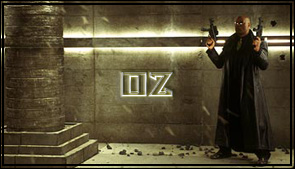 Dream Journal: Dreamwalker Chronicles Latest Entry: 01/02/2016 - "Hallway to Haven" (Lucid)(Or see the very best of my journal entries @ dreamwalkerchronicles.blogspot)
Dream Journal: Dreamwalker Chronicles Latest Entry: 01/02/2016 - "Hallway to Haven" (Lucid)(Or see the very best of my journal entries @ dreamwalkerchronicles.blogspot)
-
11-05-2008 01:25 AM #3Member



- Join Date
- Aug 2007
- LD Count
- Tons
- Gender

- Location
- Bay Area, California
- Posts
- 6,319
- Likes
- 799
- DJ Entries
- 75
I didn't see that, but it sounds awesome. I'll have to go look it up.
-
11-05-2008 01:54 AM #4Banned

- Join Date
- Apr 2007
- Location
- Out Chasing Rabbits
- Posts
- 15,193
- Likes
- 935
I thought it was a trick on the camera, but they said that if seemed like she was in the room.
Spinning mirrors wouldn't cast very sharp reflections because they project upwards, but they would have some. Cold plasma projections would though. I'll watch next time. A spinning mirror would also cast a shadow, but cold plasma wouldn't.
-
11-05-2008 02:10 AM #5
I'll bet anything that it was a realtime green screen effect along with some of that camera positioning technology they use for the first down lines and stuff for football games.
Last edited by John11; 11-05-2008 at 05:01 AM.
-
11-05-2008 03:01 AM #6never better Achievements:






- Join Date
- Aug 2007
- Gender

- Location
- BuffaLOVE, New York
- Posts
- 2,825
- Likes
- 69
Well during the shots when you would see the back of Wolf Blitzer's head whilst talking to Yellin, you could see into the screen of another camera that was facing "Jessica" and you couldn't see her in them. I'm pretty sure it was just post-pipeline additions.
So it wasn't really a holograph as they said, as much as it was some really fancy camera/computer work.Last edited by Bearsy; 11-05-2008 at 03:03 AM.

-
11-05-2008 03:54 AM #7我是老外,可是我會說一點中文。

- Join Date
- Nov 2006
- Gender

- Location
- my mind
- Posts
- 374
- Likes
- 1
Woah, that's insane!
Oneironaut - It sure sounded like they actually saw Jessica Yellin's projection in the studio.
ninja9578 - Her description of the many cameras surrounding her makes me think that the technology still needs a lot of development before we'll start seeing PCs with holographic projection capabilities. That would be awesome though. Imagine having a 3D video chat with someone half-way across the world, where it seems like you're in the same room with them. Telephones could become a thing of the past.
-
11-05-2008 04:26 AM #8Banned


- Join Date
- May 2007
- LD Count
- Loads
- Gender

- Location
- Digital Forest.
- Posts
- 6,864
- Likes
- 386
Look up the Musion Eyeliner effect.
Here: http://www.eyeliner3d.com/
Sample stuff: http://www.musionmedia.co.uk/madonna.html
http://www.musionmedia.co.uk/toyota_auris_launch.html
http://www.musionmedia.co.uk/prince_charles.htmlLast edited by A Roxxor; 11-05-2008 at 04:30 AM.
-
11-05-2008 04:31 AM #9Banned

- Join Date
- Jun 2008
- Gender

- Location
- Ontario
- Posts
- 2,119
- Likes
- 3
-
11-05-2008 04:58 AM #10我是老外,可是我會說一點中文。

- Join Date
- Nov 2006
- Gender

- Location
- my mind
- Posts
- 374
- Likes
- 1
Haha, maybe so. But the cool factor of holographic projection will certainly make it popular if and when the technology becomes sufficiently advanced for home usage.
-
11-05-2008 04:59 AM #11Banned


- Join Date
- May 2007
- LD Count
- Loads
- Gender

- Location
- Digital Forest.
- Posts
- 6,864
- Likes
- 386
-
11-05-2008 05:10 AM #12我是老外,可是我會說一點中文。

- Join Date
- Nov 2006
- Gender

- Location
- my mind
- Posts
- 374
- Likes
- 1
Prices fall as technology advances, so we both win.

-
11-05-2008 05:36 AM #13
Yeah unfortunately no one in the studio could actually see the holograph. Oh well, a few years from now, maybe.
-
11-05-2008 05:47 AM #14
-
11-05-2008 05:49 AM #15Banned


- Join Date
- May 2007
- LD Count
- Loads
- Gender

- Location
- Digital Forest.
- Posts
- 6,864
- Likes
- 386
-
11-05-2008 12:19 PM #16never better Achievements:






- Join Date
- Aug 2007
- Gender

- Location
- BuffaLOVE, New York
- Posts
- 2,825
- Likes
- 69
My favorite was how CNN had all the "magic" boards, and then NBC had people drag state shaped mats onto a giant map of the US on the rink at 30 Rock. It was very low tech... so much so that my mom laughed at it and switched off... but I felt it was kind of a fitting tribute to Tim Russert, who used that little white board every election before he passed away.
Video or the "hologram", for those that haven't seen it yet...

Blitzer is expected to use the technology to appear to talk to virtual correspondents in the CNN studio, while their physical bodies remain with the Obama and McCain campaigns. It's like a satellite appearance, except instead of appearing on a 2-D screen, it will look like the correspondents are actually on the set next to Blitzer and other anchors (see lead photo of this story).
The 3-D appearance is not an actual hologram projected into the CNN studios, but rather a virtual hologram, inserted into the video by some sophisticated real-time effects processing. To make it happen, the network has built hologram-enabled satellite sets at both campaign headquarters, in Phoenix and Chicago, that are powered by motion capture and camera tracking telemetry from VizRt and SportVu studios (known for camera tracking). At each location CNN will have more than 44 small, fixed cameras and 20 computers. The cameras will take in 360-degree images of whoever is sitting in the middle of the remote studio.
Once collected, the image data will be processed by software and visual effects, which will synchronize the camera angles on the remote correspondents with those on Blitzer, then insert the satellite feed into the main video.
According to David Bohrman, senior vice president at CNN, Mr. Blitzer and the correspondents will be addressing a 37-inch plasma screen in a regular 2-D feed in order to 'see' each other. Since they won't actually be able to see the "hologram," anchors will need a visual cue to keep from walking through the holograms — in this case, a circle on the floor.
Bohrman acknowledges this is a "very tough" project to pull off, but the tests over the last week have proven to him that it can done. "It will look very cool," he says.
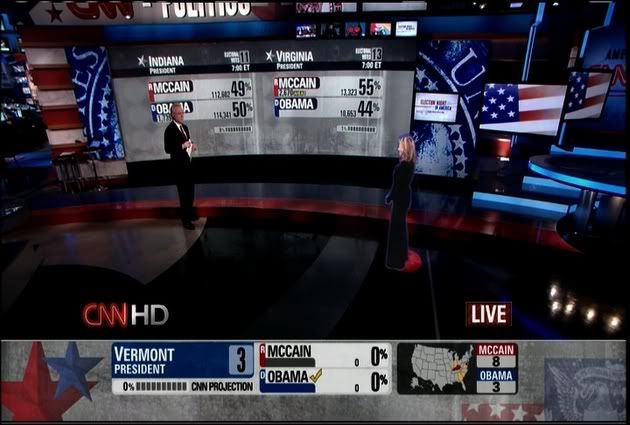
All quoted material from blog.wired.comFox News did things a little bit differently. The network designed two virtual reality studios (one for the Fox News Channel and one for Fox Broadcast) with a giant wall of touchscreens, connected together to provide electoral map results as they are released.
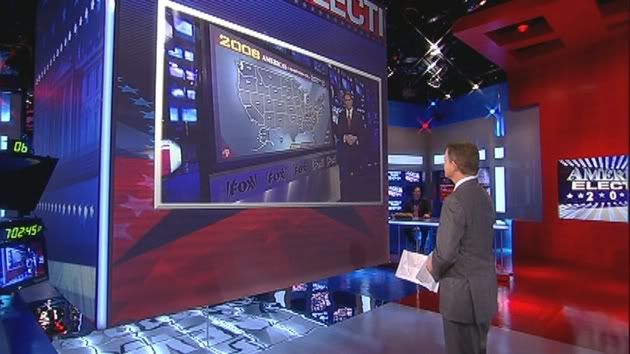
Fox is also taking the 3-D theme into the physical world by attaching large, square displays to hanging cubes in the studio. With mounted projectors overhead, the steady cam will be able to follow the anchors around the studio, as each cube panel, with 1440 x 1440 pixel resolution, follows different races. Nothing too high tech there, but the visual motion it will create will add to the show.
NBC News and MSNBC will be using BrainStorm's 3-D system to combine virtual reality with an innovative camera rig that's only been used in the movies up to now. As seen in the picture at the top of this story, Ann Curry and Chuck Todd will interact with data in a virtual environment where the telemetry of the background changes, allowing for close-up zooming and room-spanning shots. So as Todd inhabits the virtual U.S. Capitol, the angles of its virtual interior will be rendered accurately, as if he was inside for real.
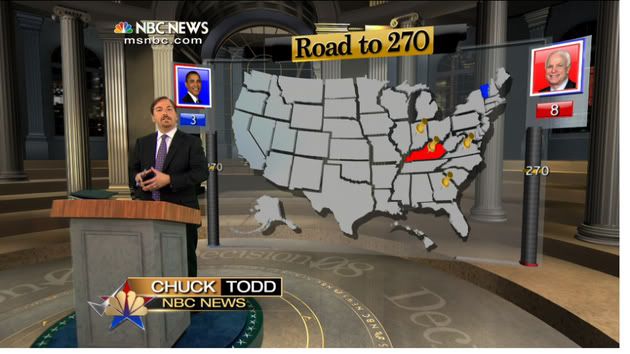
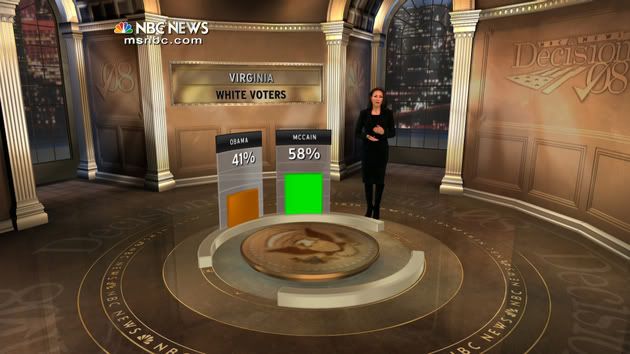

-
11-05-2008 04:39 PM #17Banned

- Join Date
- Apr 2007
- Location
- Out Chasing Rabbits
- Posts
- 15,193
- Likes
- 935
 Oh, I wanted true holograms. They're come soon.
Oh, I wanted true holograms. They're come soon.
-
11-05-2008 08:11 PM #18Banned


- Join Date
- May 2007
- LD Count
- Loads
- Gender

- Location
- Digital Forest.
- Posts
- 6,864
- Likes
- 386
Did you even see my post...?




 LinkBack URL
LinkBack URL About LinkBacks
About LinkBacks




 Reply With Quote
Reply With Quote



Bookmarks